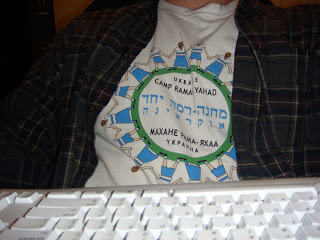A couple days ago JESNA (“advancing Jewish learning, transforming Jewish lives”) chose what it considers to be the best in Jewish education of the decade. At the conclusion of their top 10 (actually 11) list, they invited others to share their own lists. And so I have. First, here’s the JESNA list (in no particular order):
- Taglit-Birthright Israel
- Funding Partnerships
- Consumer-centric Education
- Rise of Innovation Sector
- Congregational Educational Change Initiatives
- Revitalization of Jewish camps
- Online Jewish Learning
- PJ Library
- Jewish Service Learning
- “Public Space” Jewish Education
- Focus on Outcomes
And now, here is my list of the best in Jewish education for the past decade:
Jewish Camping – I may be biased as the rabbi of a large Jewish camping agency, but Jewish summer camps are just about the only thing working these days in terms of informal Jewish education (I’ll get to those 10-day free Israel trips in a moment!). Thanks to Elisa and Rob Bildner who had the foresight to found the Foundation for Jewish Camp and to mega-donor Harold Grinspoon, Jewish camps are on the rise. The euphoric experience that thousands of Jewish kids and teens feel for a month or two each summer is the Jewish education world’s home run.
Technology – From online distance learning to Jewish utilization of social media (Facebook, Twitter, YouTube), no one can dispute that modern technology and communication have removed borders and made the global Jewish community feel much smaller. Many Jewish organizations have figured out how to use Web 2.0 applications to their advantage and many more are just beginning to navigate the terrain. I have to single out Darim, who’s “committed to assisting Jewish organizations in their efforts to increase their professionalism and relationship-building capacity through the effective use of technology.”
Indie-Minyans – I was surprised JESNA didn’t mention Hadar, which I consider the decade’s premier example of do-it-yourself Judaism, albeit in a professionalized way. Hadar began the decade as a start-up minyan (in a cramped NYC apartment) and ended it as a dynamic community that includes a yeshiva, minyan, and think tank. Hadar is educating 20- and 30-something urban Jews in fresh ways, and the established synagogues and seminaries are certainly watching closely.
JDate – Yes, I’m including an online dating website as one of the best in Jewish education for the decade. JDate has 650,000 members worldwide making it a substantial community. While it may not be a traditional education website, its members learn a lot about Judaism while searching for their potential mate. It also forces many unaffiliated Jews to feel connected with a Jewish community, and to consider their own Jewishness (and their future Jewishness). It also helps “strengthen the Jewish community and ensure that Jewish traditions are sustained for generations to come” more than most educational initiatives.
Pro-Israel Groups – I’m always amazed at the level of involvement so many unaffiliated Jews have with organizations like AIPAC and StandWithUs. These groups are committed to educating the Jewish community about Israel’s history, culture, people, and politics, as well as its struggle to survive.
Jewish Service Learning – The past decade was all about a new form of tikkun olam. More Jews than ever combined Jewish learning with a zeal for pursuing justice. This one-two punch caused organizations like AJWS, Jewish Funds for Justice, and Avodah to flourish. Jews were able to apply their Torah learning to real life situations (business ethics to the Enron and Madoff scandals, ethical kashrut to the Rubashkin/Agriprocessors debacle, pursuing global justice to Darfur, pikuach nefesh to post-9/11 security systems, etc.).
Inclusion – Gay rights in the Jewish community came about through education. The Boston-based Keshet discovered new ways to educate the community about GLBT inclusion, while a gay Orthodox rabbi came out of the closet to help create and promote a film about homosexuality in the Orthodox world. The Conservative movement’s seminaries opened their doors to gays and lesbians, and the decade ended with the majority of Reform and Conservative rabbis willing to perform commitment ceremonies for same sex couples.
Informal Ed – In each decade, JCCs and Hillels have had to adapt to new trends. These are the community centers for the Jewish people and thus, have to offer everything the Jewish community seeks — whether in the suburbs, the city, or on campus. Learning Torah with a local rabbi under the same roof you can practice Yoga, swim laps, send your toddler to pre-school or your teen to high school, have a Kosher lunch meeting, go to the theater, and rally for Israel is truly impressive. It’s possible that our JCCs are the most underrated educational agency in our Jewish community.
Post-Denominationalism – I believe the last decade prepared us for true post-denominationalism in this new decade. The last ten years saw the rise of community day schools and high schools, and therefore the growth of Ravsak — the network of these non-denominational schools. It also became common for Reform and Conservative congregations to merge in an effort for both of them to survive. In most cases, these bi-denominational mergers proved flawless. Family foundations and federations created programs, fellowships, and new organizations that transcended the movements. With mega-money from the Bronfmans, Schustermans, Steinhardts, Wexners, Davidsons, Grinspoons, and Adelsons came programs that no one denomination could claim — the STAR Foundation’s Synaplex and PEER programs, Taglit-Birthright free Israel trips, PJ Library, Avi Chai, PEJE, etc. The growth of organizations like BBYO, Melton, and Clal also demonstrate a post-denominational, informal educational spirit.
Interfaith – Through the out-of-the-box education offered by the Jewish Outreach Institute and Rabbi Kerry Olitzky, the Jewish community began to consider interfaith families in new ways. While the Reform movement was quick to welcome the interfaith family, the more traditional movements need to be educated on why this is of paramount importance to the future of Jewish peoplehood.
Conclusion: The Jewish community is always changing and it is through education that we reach new heights. In the new decade, we’ll begin to see the impact of the young Hadar-influenced leadership on synagogues and temples across the country. New advances in technology will allow us to share Jewish wisdom across continents at lightning speed. We’ll see much more collaboration between synagogues, federations, camps, and youth groups to create community-wide endeavors that will save money and reach more Jewish people quicker. We’ll also begin to determine whether the mega-philanthropists and federations are really getting the bangs for their millions of bucks with the Birthright Israel investment. Because if we don’t see real results in the coming years, we’ll regret how much money was spent on middle-class 20-somethings for their free-ride to Israel at the expense of many other important educational initiatives. Finally, the alphabet soup of Jewish communal life will get smaller as we weed out redundant organizations, and support creativity and innovation — the hallmarks of Jewish education.









